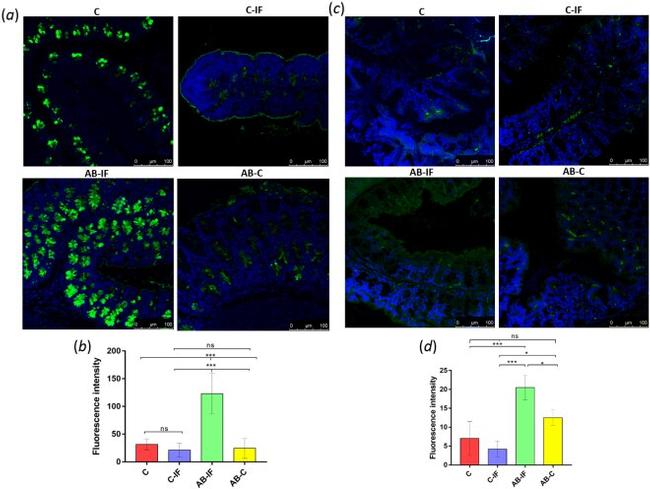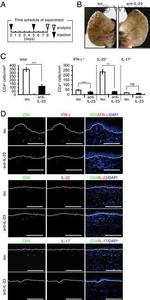Search Thermo Fisher Scientific
Invitrogen
IL-23 p19 Monoclonal Antibody (G23-8), Functional Grade, eBioscience™
产品信息
16-7232-81
种属反应
已发表种属
宿主/亚型
分类
类型
克隆号
偶联物
形式
浓度
纯化类型
保存液
内含物
保存条件
运输条件
RRID
产品详细信息
Description: The G23-8 antibody reacts with the p19 subunit of mouse IL-23. The G23-8 antibody was generated from immunization with authentic, insect cell-expressed, recombinant mouse IL-23 heterodimer. The G23-8 antibody can specifically neutralize IL-23 bioactivity with no effect on IL-12 p70 bioactivity.
The use of a p19-specific capture antibody and a p40-specific detection antibody yields an IL-23 ELISA which is exquisitely specific for mouse IL-23. IL-12 p40 homodimer and IL-12 p70 were each run in the assay at 500 ng/mL with no interference or cross-reactivity observed. A panel of 20 unrelated cytokines was run in the IL-23 ELISA at 100 ng/mL with no cross reactivity observed; all values were at the limit of detection of the assay. For measurement of total p40 protein levels, the Mouse IL-12/23 Total p40 ELISA Ready-SET-Go! is available (88-7120).
IL-23 is a heterodimeric cytokine composed of the p40 subunit of IL-12 disulfide-linked with a protein p19. p19, like p35 of IL-12, is biologically inactive by itself. IL-23 interacts with IL-12Rbeta1 and an additional, novel beta2-like receptor subunit with STAT4 binding domain, termed IL-23R. IL-23 is secreted by activated mouse and human dendritic cells. Biological activities of mouse IL-23 are distinct from those of mouse IL-12. Mouse IL-23 was found not to induce significant amounts of IFN-g. Mouse IL-23 does induce strong proliferation of memory T cells (but not naive T cells), whereas IL-12 has no effect on memory cells. Additionally, mouse IL-23 (but not IL-12) can activate mouse memory T cells to produce the proinflammatory cytokine IL-17. Human IL-23 has biological properties which are less distinct from human IL-12; human IL-23 induces proliferation of memory T cells and induces moderate levels of IFN-g production by naive and memory T cells, as compared to IL-12.
Applications Reported: The G23-8 antibody has been reported for use as the capture antibody in mouse IL-23 ELISA, for Western blotting, and for neutralization of mouse IL-23 bioactivity.
Applications Tested: The Functional Grade purified format of the G23-8 antibody has been tested as the capture antibody in an IL-23 ELISA assay (in conjunction with the biotinylated C17.8 antibody) and for neutralization of IL-23 biological activity.
For in vitro neutralization, the Functional Grade purified G23-8 antibody at 1.25 µg/mL has been found to neutralize by 50% the biological effect of 0.1 ng/mL mouse IL-23 in an assay of IL-17 secretion by mouse splenocytes. The G23-8 antibody has no effect on the bioactivity of mouse IL-12 p70. For neutralization of both IL-12 p70 and IL-23 p19p40, the anti-IL-12/IL-23 p40 antibody, clone C17.8, is recommended. Detailed information and protocols about cytokine bioassays and in vitro cytokine neutralization using antibodies can be found in the BestProtocols® section.
A suitable range of concentrations of this antibody for ELISA capture is 1-4 µg/mL. A standard curve consisting of doubling dilutions of the recombinant standard over the range of 4000 pg/mL - 30 pg/mL should be included in each ELISA plate.
Note: TMB, rather than ABTS, should be used as a substrate to achieve this sensitivity level.
Storage and handling: Use in a sterile environment.
Filtration: 0.2 µm post-manufacturing filtered.
Purity: Greater than 90%, as determined by SDS-PAGE.
Endotoxin Level: Less than 0.001 ng/µg antibody, as determined by LAL assay.
Aggregation: Less than 10%, as determined by HPLC.
靶标信息
IL-23 is a heterodimeric cytokine composed of the p40 subunit of IL-12 disulfide-linked with a protein p19. p19, like p35 of IL-12, is biologically inactive by itself. IL-23 interacts with IL-12Rbeta1 and an additional, novel beta2-like receptor subunit with STAT4 binding domain, termed IL-23R. IL-23 is secreted by activated mouse and human dendritic cells. Biological activities of mouse IL-23 are distinct from those of mouse IL-12. Mouse IL-23 was found not to induce significant amounts of IFN-γ. Mouse IL-23 does induce strong proliferation of memory T cells (but not naive T cells), whereas IL-12 has no effect on memory cells. Additionally, mouse IL-23 (but not IL-12) can activate mouse memory T cells to produce the proinflammatory cytokine IL-17. Human IL-23 has biological properties which are less distinct from human IL-12; human IL-23 induces proliferation of memory T cells and induces moderate levels of IFN-γ production by naive and memory T cells, as compared to IL-12.
仅用于科研。不用于诊断过程。未经明确授权不得转售。
生物信息学
蛋白别名: il 23; IL 23 A; Il-12b; Il-12p40; IL-23 subunit alpha; IL-23-A; IL-23p19; IL12B; Il12p40; il23; ILN; Interleukin; interleukin 12B; Interleukin-23 subunit alpha; Interleukin-23 subunit p19; MGC79388; RP23-388G23.1
基因别名: IL-23; Il23a; p19
UniProt ID: (Mouse) Q9EQ14
Entrez Gene ID: (Mouse) 83430





